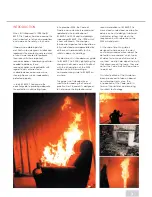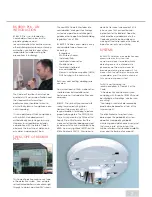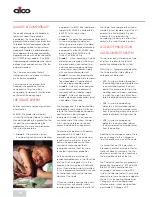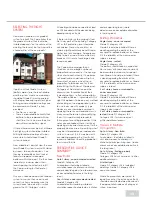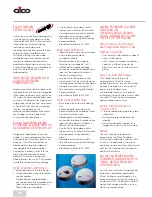
Fires caused by electrical appliances
account for some 10% of all household
fires, but result in only 6% of deaths. Electric
blankets and bed warmers cause 40% of
all the deaths in fires due to faulty electrical
appliances. The Code says that ‘use of
electric blankets, particularly by high risk
groups such as the elderly, increases the
justification for providing smoke alarms in
bedrooms’. As with smoking materials, by
the time an alarm in an adjacent area
detects smoke, it may be too late.
Finally, the new 2004 Code acknowledges
that there is a very worrying increase in the
incidence of arson, just as it did back in
1995. Malicious ignition is the second most
common source of ignition in all fires in
dwellings. Arson is particularly worrying in
multiple occupancy dwellings and the Code
stresses that the level of fire protection in
such places needs to be very high if there is
a significant risk of malicious fire-raising. It
even goes so far as to suggest installing
alarms near the door in case inflammable
materials are pushed through the letterbox.
WHO IS MOST AT RISK?
The occupants of a property are another
significant factor which needs to be
considered.
The Code acknowledges that elderly
people are at ‘significantly greater risk’
from fire than other age groups. For those
over 80, the probability of dying in a fire is
several times that for those aged from 30
to 59. Those aged between 60 and 80
are also at increased risk. Children under
five are at greater risk than adults.
For that reason, the Code recommends
greater levels of fire protection in
dwellings occupied by the elderly or
those with young children.
9
FIRE RISK -
WHERE DO FIRES START?
J
ust over half of all fatalities occur in the
room where the fire breaks out; in HMOs,
this rises to 60%. The Code notes that, in
the United Kingdom, some 40% of all
fatal fires start in living rooms or dining
rooms, whereas 30% of fatal fires start in
bedrooms. For this reason, the Code
recommends that if alarms are to be
installed within rooms, the living room
and the dining room should be the first
priority. However, this consideration
could be reversed if the bedroom
presents a particular fire risk, such as the
occupant smoking in bed or using an
electric blanket.
The Code also specifically warns that
occupants – especially those asleep
and/or with a closed door between
them and the alarm - may not hear the
alarm in time. It stresses that it is
‘therefore essential that fire detection
and fire alarm systems are capable of
operating correctly when occupants
are asleep and are capable of rousing
occupants from normal sleep.’ This is
another reason why - if there is a
significant fire risk in a particular room -
consideration should be given to
installing alarms in that room - and
interlinking the entire system.
After kitchen fires and electrical
appliances and wiring, smoking
continues to be the next most common
cause of accidental fires in the home.
However, it is the number one cause of
fire deaths. Around 40% of all fire
deaths are caused through matches or
a discarded cigarette (the figure was
33% in1995 when the Code was first
published). In most cases, the item
ignited is bedding or furniture. If
occupants are known to smoke, there is
a greater need to install smoke alarms in
the living room or dining room areas. If
the occupants smoke in bed, the Code
suggests considering installing smoke
alarms in the bedroom itself. Ominously,
statistics reveal that - if such a fire begins
in a room where an occupant is asleep -
their chances of survival are greatly
reduced. By the time an alarm sounds in
an adjacent area, it may very well
already be too late.
Fires caused by space heating
appliances are also particularly life
threatening. After fires caused by
smoking and cooking appliances, these
types of fires account for more deaths
than any other cause - around 12% of
accidental fire deaths. These fires often
occur when something inflammable is
placed too close to the heater. The
Code suggests that, if portable heaters
or solid fuel fires are used at night, there
may be good justification for installing
smoke alarms in the relevant rooms -
particularly bedrooms.
MOST COMMON CAUSES OF ACCIDENTAL FIRES



